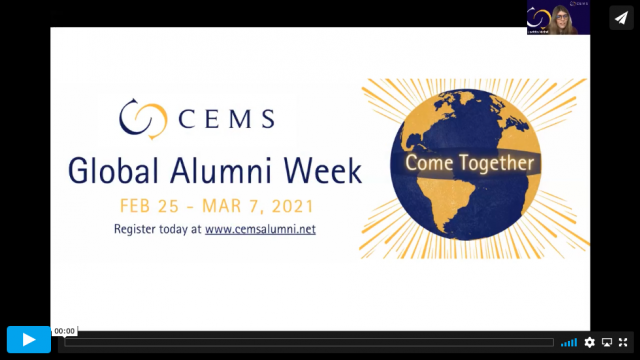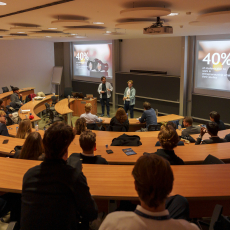I recently had the pleasure of discussing my latest book Return on Ambition (video) with a group of CEMS alumni and students during the Global Alumni Week. It was a lively and rich discussion, and I learned a great deal from the participants.
Your ambition is often the biggest investment you make in life, yet measuring and managing what you are getting out of it – your return – is often challenging. I’ve experienced first-hand how ambition can drive one to great heights but also lead to crashes. Ever since experiencing burnout at age 21, ambition has always been very personal for me. For the last 5 years I have been studying it more extensively together with my co-author Nicolai Tillisch. We learned a great deal when researching it through lenses such as psychology, neuroscience, and ancient wisdom traditions, and we also conducted countless interviews and a global survey to further sharpen our insights. Below are 5 tips to maximise your Return on Ambition.
Sharpen the premises of your ambition.
It is easy to get caught up in what others are doing and be tempted to follow a similar path. However, the degree and nuances of your ambitions are highly personal, and getting clear about the premises of what you aspire to accomplish is the first step toward measuring and maximizing it. Below are questions relating to the four premises of ambition – specificity, uniqueness, size, and priority – that I invite you to reflect on:
- How specific is your ambition? To what extent is your ambition a broad direction versus a clearly articulated destination?
- How unique is your ambition? Do you wish to follow a well-trodden path or carve out your own niche?
- How big are your ambitions relative to where you are today? How far will you have to reach to get there?
- Are your ambitions one of your many priorities, or does your life revolve around your ambitions?
The clearer a picture you have about how your ambitions fall along the four premises, the better a foundation you have for pursuing them and assessing whether—and when—you can consider yourself successful and fulfilled.
Consider your returns across achievement, growth, and well-being.
To uncover the factors that lead to a “high” Return on Ambition, we looked at elements that ambitious people believe made the biggest difference in achieving a high return. In our research, we defined a high Return on Ambition as “being fulfilled and satisfied with life, relative to your ambition.” Similarly, we studied people who didn’t feel they have realized a high Return on Ambition. We found that those who reported feeling satisfied generally scored high over time across three core areas in their lives:
- Achievement: Personal and professional goals that are meaningful, challenging, and utilize your strengths
- Growth: Personal development, skill acquisition and adaptability to new situations and challenges
- Well-being: Physical, emotional, social, and spiritual aspects of your life
Although dips sometimes occurred in each of these areas, they were usually short-lived. On the other hand, people who reported feeling less satisfied and who scored low on Return on Ambition fell short in one or two of these three areas for extended periods of time.
Identify the Frenemies that get in the way.
In our interviews and work with ambitious people, we’ve found they share similar mindsets and behavioral patterns that helped them reach their aspirations and become fulfilled. These shared characteristics are typically considered strengths or “friends” of ambition. Examples include the ability to handle complex tasks independently, to adapt to new situations, and to compete and win—all great qualities. However, the exact mindsets of ambitious people, precisely because they are so ambitious, can also turn into “enemies” of ambition. The result is what we call the “Frenemies” of ambition. We’ve identified seven of these traits, which you must become aware of before you can overcome their negative manifestations:
- CONVENTION—The ability to follow a well-trodden path and attain success as judged by society . . . or to get stuck in expectation and routine.
- BOLDNESS—The ability to move quickly and throw yourself into new, challenging situations . . . or to miscalculate what is required to attain your ambitions.
- INDEPENDENCE—The ability to get things done by yourself, without help . . . or to fail to include others when needed.
- COMPETITIVENESS—The ability to outcompete others and be the best . . . or to try to win at all costs.
- PERSEVERANCE—The ability to go the extra mile and complete challenging tasks, even when you’re overloaded . . . or to exhaust yourself frequently and burn out.
- DESIRE—The ability to push constantly against the limits of possibility and break new boundaries . . . or to chase success for the sake of it.
- FLEXIBILITY—The ability to adapt adroitly to different people and situations . . . or to be constantly swayed by others.
For example, we interviewed Amelia Boone as part of our research, and she illustrates the Perseverance Frenemy. Boone is a full-time attorney at Apple, and also one of the world’s most successful obstacle racers, with three World’s Toughest Mudder titles, one Spartan World Championship, 50 podium finishes, and multiple race victories. She juggles a full-time corporate job with 70–90 miles of running per week, as well as regular CrossFit workouts. She recalls the tendency she has to push herself beyond the point of exhaustion. Undoubtedly this ability has helped her win many races, but she has also learned the hard way that more is not always better. When Boone injured her leg running, her first instinct was to work harder and come back stronger. “The day after I was diagnosed, I was in the pool swimming with a buoy between my legs for as long as my bored mind could take, staring at the line on the pool floor through tears in my goggles. I’d get on an Assault stationary bike and work my arms and one leg. Somewhere along the way, I came up with the brilliant idea that crutches could be a form of exercise.”
Boone was secretly proud of her progress, but she failed to appreciate the incredible toll it took on her body. “What I didn’t realize was that through the intense cross-training, I was building really bad habits and imbalances. Three weeks after I got off crutches for the femoral stress fracture and started to return to running, I ended up with a sacral stress fracture—a crack in the bone at the base of the spine—on my left side, where I was doing all that biking, standing on one leg, and hopping on one leg crutching around. Then I knew I had completely screwed up. A six-month sentence of no running suddenly doubled to a year.”
Activate your Frenemy Radar.
Once you have defined your true ambition, reflected on your current returns and biggest areas of opportunity, and considered which Frenemies might get in your way, it is time to put what you’ve learned into practice. One of the tools we introduce in the book is the Frenemy Radar, which is your evolving map of where and when your Frenemies cause sensations and friction. Much like an airplane scanner which is gauging its surroundings for irregularities, your Frenemy Radar can help uncover when a Frenemy is creeping up on you, and allows you to choose a more deliberate response when triggered. Follow these 4 steps to get going:
- Sense: Tune into yourself by taking a couple of deep breaths and practice noticing your feelings, emotions and thoughts in real time. This will help you notice Frenemies which appear from time to time
- Adapt: When you feel a Frenemy about the trigger you, pause and adapt your behavior. It can take up to 10 seconds for you to fully comprehend the situation and overpower your Frenmey. You may not always be successful in adapting in the moment, but each attempt helps to mitigate the Frenemy in the future
- Note: As soon as the incident is over, make a note of what happened, how you felt in your body and thoughts, and how you acted.
- Explore: Finally, wait 3 hours but not more than 24 hours to spend dedicated time to reflect on the underlying causes of the Frenemy. Why did it appear? How might you manage it better? What will you do differently next time?
Although the sequence is simple, it requires practice. Continue to refine your radar by aiming to have 2-3 reflections each week.
Don’t lose sight of what makes you special
When you work against your Frenemies, it feels unnatural because they are so ingrained in how you learned to make sense of yourself and of the world. At times, you may feel like they are so overpowering that you need to eliminate them from your life. However, your Frenemies have been developed throughout your lifetime, and are part and parcel of who you are. They carry with them special gifts that undoubtedly have helped you in the past, and which you will need to rely on in the future.
As such, focus more on becoming aware of your Frenemies and sharpening your Frenemy Radar so you are managing them instead of the other way around. Avoid labeling your actions as “bad” or being too harsh on yourself. Trust that self-reflection and consistent changes will expand your ability to make more conscious and intentional choices over time. Maximizing your Return on Ambition is a lifelong journey, and seeing it as an ongoing opportunity to optimise your levels of achievement, growth and well-being while nurturing ever-deeper relationships with 7 friends is much more inspiring than trying to fight off your enemies.





